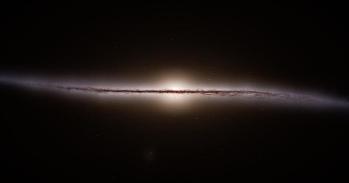
Astronomers have used the NASA/ESA James Webb Space Telescope to confirm that supermassive black holes can starve their host galaxies of the fuel they need to form new stars.
Astronomers have used the NASA/ESA James Webb Space Telescope to confirm that supermassive black holes can starve their host galaxies of the fuel they need to form new stars.
The international team, co-led by the University of Cambridge, used Webb to observe a galaxy roughly the size of the Milky Way in the early universe, about two billion years after the Big Bang. Like most large galaxies, it has a supermassive black hole at its centre. However, this galaxy is essentially ‘dead’: it has mostly stopped forming new stars.
“Based on earlier observations, we knew this galaxy was in a quenched state: it’s not forming many stars given its size, and we expect there is a link between the black hole and the end of star formation,” said co-lead author Dr Francesco D’Eugenio from Cambridge’s Kavli Institute for Cosmology. “However, until Webb, we haven’t been able to study this galaxy in enough detail to confirm that link, and we haven’t known whether this quenched state is temporary or permanent.”
This galaxy, officially named GS-10578 but nicknamed ‘Pablo’s Galaxy’ after the colleague who decided to observe it in detail, is massive for such an early period in the universe: its total mass is about 200 billion times the mass of our Sun, and most of its stars formed between 12.5 and 11.5 billion years ago.
“In the early universe, most galaxies are forming lots of stars, so it’s interesting to see such a massive dead galaxy at this period in time,” said co-author Professor Roberto Maiolino, also from the Kavli Institute for Cosmology. “If it had enough time to get to this massive size, whatever process that stopped star formation likely happened relatively quickly.”
Using Webb, the researchers detected that this galaxy is expelling large amounts of gas at speeds of about 1,000 kilometres per second, which is fast enough to escape the galaxy’s gravitational pull. These fast-moving winds are being ‘pushed’ out of the galaxy by the black hole.
Like other galaxies with accreting black holes, ‘Pablo’s Galaxy’ has fast outflowing winds of hot gas, but these gas clouds are tenuous and have little mass. Webb detected the presence of a new wind component, which could not be seen with earlier telescopes. This gas is colder, which means it’s denser and – crucially – does not emit any light. Webb, with its superior sensitivity, can see these dark gas clouds because they block some of the light from the galaxy behind them.
The mass of gas being ejected from the galaxy is greater than what the galaxy would require to keep forming new stars. In essence, the black hole is starving the galaxy to death. The results are reported in the journal Nature Astronomy.
“We found the culprit,” said D’Eugenio. “The black hole is killing this galaxy and keeping it dormant, by cutting off the source of ‘food’ the galaxy needs to form new stars.”
Although earlier theoretical models had predicted that black holes had this effect on galaxies, before Webb, it had not been possible to detect this effect directly.
Earlier models had predicted that the end of star formation has a violent, turbulent effect on galaxies, destroying their shape in the process. But the stars in this disc-shaped galaxy are still moving in an orderly way, suggesting that this is not always the case.
“We knew that black holes have a massive impact on galaxies, and perhaps it’s common that they stop star formation, but until Webb, we weren’t able to directly confirm this,” said Maiolino. “It’s yet another way that Webb is such a giant leap forward in terms of our ability to study the early universe and how it evolved.”
New observations with the Atacama Large Millimeter-Submillimiter Array (ALMA), targeting the coldest, darkest gas components of the galaxy, will tell us more about if and where any fuel for star formation is still hidden in this galaxy, and what is the effect of the supermassive black hole in the region surrounding the galaxy.
The research was supported in part by the Royal Society, the European Union, the European Research Council, and the Science and Technology Facilities Council (STFC), part of UK Research and Innovation (UKRI).
Reference:
Francesco D’Eugenio, Pablo G. Pérez-González et al. ‘A fast-rotator post-starburst galaxy quenched by supermassive black-hole feedback at z=3.’ Nature Astronomy (2024). DOI: 10.1038/s41550-024-02345-1

The text in this work is licensed under a Creative Commons Attribution-NonCommercial-ShareAlike 4.0 International License. Images, including our videos, are Copyright ©University of Cambridge and licensors/contributors as identified. All rights reserved. We make our image and video content available in a number of ways – on our main website under its Terms and conditions, and on a range of channels including social media that permit your use and sharing of our content under their respective Terms.




